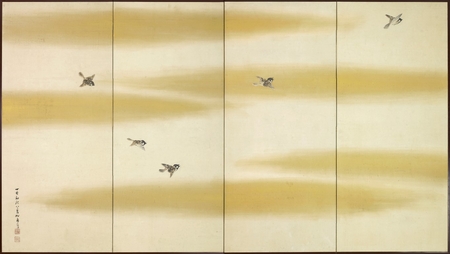Product Description
6999 A four-fold paper screen painted in ink and colour on a buff ground with five flying suzume (sparrows) among golden clouds
Signed: Hinoto i shoshū kin’ō Shōrin sha (Painted by Shōrin, official painter and old man, in early autumn of the Hinoto i year*)
Seals:
Upper: Fuji in Kōbun (seal of Fuji Kōbun)
Lower: Shōrin
Japan 19th century Meiji period *1887
Dimensions: H. 54″ x W. 95″ (137cm x 241cm)
Fujii Shōrin (1824-1894) Gō (art name): Kōbun, Seien, Hyakusai. Born as the oldest son to a feudal lord in Chōjamachi near the Fukuyama castle Hiroshima, Shōrin was an official painter who served at the Fukuyama Domain (Bingo province).
He started his career in 1837 at 14 years old and became a young painting assistant in order to manifest his talent in painting. After a 10-year apprenticeship Shōrin decided this was the correct path for him and set his mind on Kyoto and its painting circles.
In 1856, after completing a coastal defense survey map for his hometown Fukuyama feud he moved to Kyoto where he became a disciple of the Maruyama School master Nakajima Raishō (1796-1871). He became friends with other prominent artists of master Raihō’s art circle such as Mori Kansai (1814-1894), Kōno Bairei (1844-1895) and Kawabata Gyokushō (1842-1913) amongst others. Shōrin also studied waka poetry under Ōkuni Takamasa (1793-1871) and Matsumoto Yoshitō (1814-1879).
In 1859 Shōrin returned to his family and continued working in a double post as an official cartographer and a commissioner at the Fukuyama Shogunate Account Magistrate Office.
Recognition amongst the artistic circles came later in his 50’s with an array of National exhibition participations, honourable mentions, Imperial donations and awards for excellence in painting. His painting of swimming koi (carp) fish painted in 1889 is said to have challenged similar paintings by Maruyama Ōkyo and the realism expressed in the animation of figures and facial features of his painting of 100 wise and lucky men was considered an equal match to the illustrations of Hokusai.
His greatest achievement however was a three-year project completed in 1893 when Shōrin was 70 years old. He was commissioned to cover the walls and fusuma doors of the Abbot’s champers and living quarters of Jōdo-ji in Onomichi Hiroshima with his paintings of animals, plants and landscapes. The temple was so densely decorated with Shōrin’s art that it became known as Shōrin-ji (lit. Shōrin’s temple).
Shōrin is buried in Hōshin-ji at Yoshizu Fukuyama and two pine trees are planted next to his tombstone.
Works by the artist can be found in the collection of Fukuyama Museum of Art, Hiroshima.
Suzume (sparrow) is said to be obsessed with honour and especially with the repaying of debts making it a particularly popular subject matter with the samurai class.









